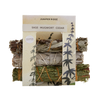
Hall, our founder, has been hiking redwood trails for years. We generally harvest wild overgrowth because working with plants can have a lasting impact on the plants themselves and ecosystem if not done carefully. Harvesting, especially roots, is delicate work. Best for personal use and armed with lots of info in the plant itself and how best harvest it.
99.9% of the plant material we harvest is evergreen trimmings, perennial shrub trimmings and annual herbs; stuff that can be easily trimmed without having any impact on the plant or larger ecosystem surrounding it. When we’re digging roots, we have to work with caution because gathering roots essentially means killing the plant. We rarely do this. We take steps to make sure we are gentle on the surrounding ecosystem.
Here are some guidelines for sustainable harvesting, which we model our standards after:
- Do you have the permission or the permits for collecting at the site?
- Are you at the proper elevation?
- Is there any natural or chemical contamination?
- Are there rare, threatened, endangered, or sensitive plants growing nearby at any time of the year?
- Is wildlife foraging the stand?
- Do you have the proper emotional state?
- Look around after harvesting. Any holes or cleanup needed?
- Are you picking herbs in the proper order for a long trip?
It’s a long, thorough list, but following it in detail keeps us diligent and responsible in our work. In addition to meeting the qualifications on this list, we make sure to only take excess growth, that is, smaller plants that won’t survive in the middle of larger, mature plants. Generally speaking, we harvest one plant for every hundred you see.






















